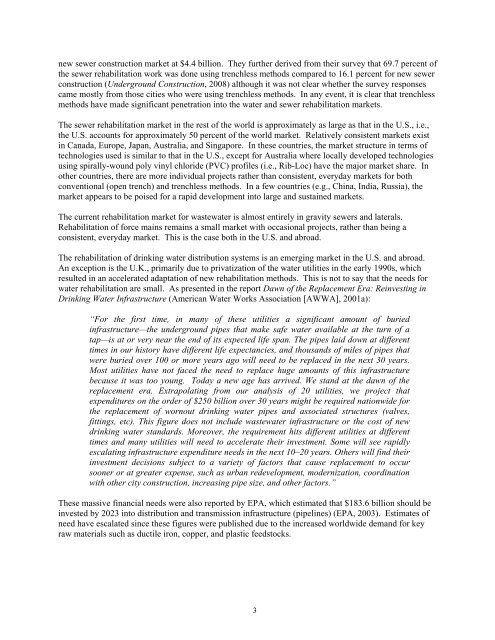Rehabilitation of Wastewater Collection and Water Distribution ...
Rehabilitation of Wastewater Collection and Water Distribution ...
Rehabilitation of Wastewater Collection and Water Distribution ...
Create successful ePaper yourself
Turn your PDF publications into a flip-book with our unique Google optimized e-Paper software.
new sewer construction market at $4.4 billion. They further derived from their survey that 69.7 percent <strong>of</strong><br />
the sewer rehabilitation work was done using trenchless methods compared to 16.1 percent for new sewer<br />
construction (Underground Construction, 2008) although it was not clear whether the survey responses<br />
came mostly from those cities who were using trenchless methods. In any event, it is clear that trenchless<br />
methods have made significant penetration into the water <strong>and</strong> sewer rehabilitation markets.<br />
The sewer rehabilitation market in the rest <strong>of</strong> the world is approximately as large as that in the U.S., i.e.,<br />
the U.S. accounts for approximately 50 percent <strong>of</strong> the world market. Relatively consistent markets exist<br />
in Canada, Europe, Japan, Australia, <strong>and</strong> Singapore. In these countries, the market structure in terms <strong>of</strong><br />
technologies used is similar to that in the U.S., except for Australia where locally developed technologies<br />
using spirally-wound poly vinyl chloride (PVC) pr<strong>of</strong>iles (i.e., Rib-Loc) have the major market share. In<br />
other countries, there are more individual projects rather than consistent, everyday markets for both<br />
conventional (open trench) <strong>and</strong> trenchless methods. In a few countries (e.g., China, India, Russia), the<br />
market appears to be poised for a rapid development into large <strong>and</strong> sustained markets.<br />
The current rehabilitation market for wastewater is almost entirely in gravity sewers <strong>and</strong> laterals.<br />
<strong>Rehabilitation</strong> <strong>of</strong> force mains remains a small market with occasional projects, rather than being a<br />
consistent, everyday market. This is the case both in the U.S. <strong>and</strong> abroad.<br />
The rehabilitation <strong>of</strong> drinking water distribution systems is an emerging market in the U.S. <strong>and</strong> abroad.<br />
An exception is the U.K., primarily due to privatization <strong>of</strong> the water utilities in the early 1990s, which<br />
resulted in an accelerated adaptation <strong>of</strong> new rehabilitation methods. This is not to say that the needs for<br />
water rehabilitation are small. As presented in the report Dawn <strong>of</strong> the Replacement Era: Reinvesting in<br />
Drinking <strong>Water</strong> Infrastructure (American <strong>Water</strong> Works Association [AWWA], 2001a):<br />
“For the first time, in many <strong>of</strong> these utilities a significant amount <strong>of</strong> buried<br />
infrastructure—the underground pipes that make safe water available at the turn <strong>of</strong> a<br />
tap—is at or very near the end <strong>of</strong> its expected life span. The pipes laid down at different<br />
times in our history have different life expectancies, <strong>and</strong> thous<strong>and</strong>s <strong>of</strong> miles <strong>of</strong> pipes that<br />
were buried over 100 or more years ago will need to be replaced in the next 30 years.<br />
Most utilities have not faced the need to replace huge amounts <strong>of</strong> this infrastructure<br />
because it was too young. Today a new age has arrived. We st<strong>and</strong> at the dawn <strong>of</strong> the<br />
replacement era. Extrapolating from our analysis <strong>of</strong> 20 utilities, we project that<br />
expenditures on the order <strong>of</strong> $250 billion over 30 years might be required nationwide for<br />
the replacement <strong>of</strong> wornout drinking water pipes <strong>and</strong> associated structures (valves,<br />
fittings, etc). This figure does not include wastewater infrastructure or the cost <strong>of</strong> new<br />
drinking water st<strong>and</strong>ards. Moreover, the requirement hits different utilities at different<br />
times <strong>and</strong> many utilities will need to accelerate their investment. Some will see rapidly<br />
escalating infrastructure expenditure needs in the next 10–20 years. Others will find their<br />
investment decisions subject to a variety <strong>of</strong> factors that cause replacement to occur<br />
sooner or at greater expense, such as urban redevelopment, modernization, coordination<br />
with other city construction, increasing pipe size, <strong>and</strong> other factors.”<br />
These massive financial needs were also reported by EPA, which estimated that $183.6 billion should be<br />
invested by 2023 into distribution <strong>and</strong> transmission infrastructure (pipelines) (EPA, 2003). Estimates <strong>of</strong><br />
need have escalated since these figures were published due to the increased worldwide dem<strong>and</strong> for key<br />
raw materials such as ductile iron, copper, <strong>and</strong> plastic feedstocks.<br />
3















